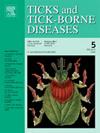挪威病人和蜱虫样本中蜱传脑炎病毒的新变异
IF 3.4
2区 医学
Q2 INFECTIOUS DISEASES
引用次数: 0
摘要
挪威每年的蜱传脑炎(TBE)病例数量从1998年的1例急剧增加到2023年的113例。从临床样本和蜱虫媒介中鉴定TBEV基因组是了解疾病严重程度和传播动力学的必要条件。然而,携带完整病毒的临床样本很少,因为TBE通常在病毒血症后阶段通过血清学诊断,此时病毒载量较低,无法通过聚合酶链反应(PCR)等分子方法检测到。迄今为止,Mandal-2009是挪威唯一具有完整病毒基因组的TBEV序列,直接从蜱虫媒介中测序。我们采用新设计的重叠引物对、纳米孔测序和Sanger测序相结合的方法,从挪威患者和蜱虫样本中获得了几乎完整的TBEV基因组。患者有严重的TBE合并噬血细胞性淋巴组织细胞增多症(HLH)。患者和蜱虫样本分别在Telemark县和Vestfold县相隔16公里处采集。两两基因组比较显示,同源性为99.7%,系统发育分析显示,这些序列与来自芬兰Åland Kumlinge的TBEV毒株密切相关,而不是先前发表的挪威变异Mandal-2009。这些发现证实了在挪威泰勒马克县和韦斯特福尔德县的流行地区存在新的TBEV变异。我们的研究结果强调了对挪威和欧洲新型TBEV基因组进行持续监测和表征的必要性。本文章由计算机程序翻译,如有差异,请以英文原文为准。
Novel variants of tick-borne encephalitis virus from patient and tick samples in Norway
The annual number of tick-borne encephalitis (TBE) cases in Norway has increased dramatically from 1 case in 1998 to 113 in 2023. Characterization of TBE virus (TBEV) genomes from both clinical samples and tick vectors is necessary to understand disease severity and transmission dynamics. However, clinical samples with intact virus are rare because TBE is usually diagnosed by serology in the post-viremic phase, when the viral load is low and undetectable by molecular methods such as polymerase chain reaction (PCR). To date, Mandal-2009 is the only TBEV sequence from Norway with complete virus genome, sequenced directly from the tick vector. We used a combined approach with newly designed overlapping primer pairs and nanopore sequencing together with Sanger sequencing to obtain nearly complete TBEV genomes from both patient and tick samples from Norway. The patient had severe TBE complicated with hemophagocytic lymphohistiocytosis (HLH). The patient and tick samples were collected 16 km apart, from Telemark and Vestfold Counties, respectively. Pairwise genomic comparison showed 99.7 % identity, and phylogenetic analysis revealed that these sequences were closely related to the TBEV strain from Kumlinge in Åland, Finland, rather than to the previously published Norwegian variant Mandal-2009. These findings confirm the existence of novel TBEV variants in the endemic areas of Telemark and Vestfold Counties of Norway. Our findings highlight the need for continuous monitoring and characterization of novel TBEV genomes in Norway and Europe.
求助全文
通过发布文献求助,成功后即可免费获取论文全文。
去求助
来源期刊

Ticks and Tick-borne Diseases
INFECTIOUS DISEASES-MICROBIOLOGY
CiteScore
6.90
自引率
12.50%
发文量
185
审稿时长
6-12 weeks
期刊介绍:
Ticks and Tick-borne Diseases is an international, peer-reviewed scientific journal. It publishes original research papers, short communications, state-of-the-art mini-reviews, letters to the editor, clinical-case studies, announcements of pertinent international meetings, and editorials.
The journal covers a broad spectrum and brings together various disciplines, for example, zoology, microbiology, molecular biology, genetics, mathematical modelling, veterinary and human medicine. Multidisciplinary approaches and the use of conventional and novel methods/methodologies (in the field and in the laboratory) are crucial for deeper understanding of the natural processes and human behaviour/activities that result in human or animal diseases and in economic effects of ticks and tick-borne pathogens. Such understanding is essential for management of tick populations and tick-borne diseases in an effective and environmentally acceptable manner.
 求助内容:
求助内容: 应助结果提醒方式:
应助结果提醒方式:


